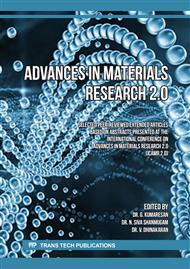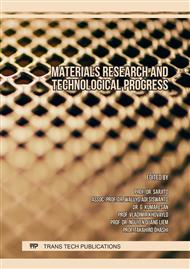[1]
H.Y. Li, D.F. Luo, C.F. Yeung, K.H. Lau, Microstructural studies of QPQ complex salt bath heat-treated steels, Journal of Materials Processing Technology. 69 (1997) 45–49. https://doi.org/10.1016/S0924-0136(96)00037-4.
DOI: 10.1016/s0924-0136(96)00037-4
Google Scholar
[2]
G. jiang Li, Q. Peng, J. Wang, C. Li, Y. Wang, J. Gao, S. yuan Chen, B. luo Shen, Surface microstructure of 316L austenitic stainless steel by the salt bath nitrocarburizing and post-oxidation process known as QPQ, Surface and Coatings Technology. 202 (2008) 2865–2870. https://doi.org/10.1016/j.surfcoat.2007.10.032.
DOI: 10.1016/j.surfcoat.2007.10.032
Google Scholar
[3]
N. Mandkarian, F. Mahboubi, Effect of gas mixture of plasma post-oxidation on corrosion properties of plasma nitrocarburised AISI 4130 steel, Vacuum. 83 (2009) 1036–1042. https://doi.org/10.1016/j.vacuum.2009.01.010.
DOI: 10.1016/j.vacuum.2009.01.010
Google Scholar
[4]
F. Sun, W. Cai, F. Meng, J. Hu, Influence of QPQ treatment on the corrosion behavior for carbon steel, Applied Mechanics and Materials. 155–156 (2012) 922–925. https://doi.org/10.4028/www.scientific.net/AMM.155-156.922.
DOI: 10.4028/www.scientific.net/amm.155-156.922
Google Scholar
[5]
K. Wang, D.F. Luo, L. Zhang, Research on fast nitriding by direct current field base on the deeplayer QPQ technology, Physics Procedia. 50 (2013) 113–119. https://doi.org/10.1016/j.phpro.2013.11.019.
DOI: 10.1016/j.phpro.2013.11.019
Google Scholar
[6]
K. Dybowski, J. Sawicki, P. Kula, B. Januszewicz, R. Atraszkiewicz, S. Lipa, The effect of the quenching method on the deformations size of gear wheels after vacuum carburizing, Archives of Metallurgy and Materials. 61 (2016) 1057–1062. https://doi.org/10.1515/amm-2016-0178.
DOI: 10.1515/amm-2016-0178
Google Scholar
[7]
S.C. Ikpeseni, Effect of Intermediate Quenching and Tempering on the Mechanical Behaviour of Low Carbon Steel, International Journal of Advanced Engineering Research and Science. 4 (2017) 1–10. https://doi.org/10.22161/ijaers.4.8.1.
DOI: 10.22161/ijaers.4.8.1
Google Scholar
[8]
P. Skubisz, J. Sinczak, Properties of direct-quenched aircraft forged component made of ultrahigh-strength steel 300M, Aircraft Engineering and Aerospace Technology. (2018). https://doi.org/10.1108/AEAT-12-2015-0253.
DOI: 10.1108/aeat-12-2015-0253
Google Scholar
[9]
H. Xiang, G. Wu, D. Liu, H. Cao, X. Dong, Effect of quench polish quench nitriding temperature on the microstructure and wear resistance of saf2906 duplex stainless steel, Metals. 9 (2019) 1–10. https://doi.org/10.3390/met9080848.
DOI: 10.3390/met9080848
Google Scholar
[10]
O. Heidary, O. Mirzaee, A.H. Raouf, E. Borhani, UP-quenched SAE 4130 steel: Mechanical properties assessment and bainite formation, Materials Science and Engineering A. 787 (2020). https://doi.org/10.1016/j.msea.2020.139479.
DOI: 10.1016/j.msea.2020.139479
Google Scholar
[11]
E. Ghelloudj, Microstructure, mechanical and tribological behaviour of aisi 316l stainless steel during salt bath nitriding, Acta Metallurgica Slovaca. 27 (2021) 47–52. https://doi.org/10.36547/ams.27.2.952.
DOI: 10.36547/ams.27.2.952
Google Scholar
[12]
N. Yasavol, F. Mahboubi, The effect of duplex plasma nitriding-oxidizing treatment on the corrosion resistance of AISI 4130 steel, Materials and Design. 38 (2012) 59–63. https://doi.org/10.1016/j.matdes.2012.01.047.
DOI: 10.1016/j.matdes.2012.01.047
Google Scholar
[13]
S. Boopathi, A. Thillaivanan, M. Pandian, R. Subbiah, P. Shanmugam, Friction stir processing of boron carbide reinforced aluminium surface (Al-B4C) composite: Mechanical characteristics analysis, Materials Today: Proceedings. 50 (2022) 2430–2435. https://doi.org/10.1016/j.matpr.2021.10.261.
DOI: 10.1016/j.matpr.2021.10.261
Google Scholar
[14]
B. Sampath, S. Myilsamy, Experimental investigation of a cryogenically cooled oxygen-mist near-dry wire-cut electrical discharge machining process, Strojniski Vestnik/Journal of Mechanical Engineering. 67 (2021) 322–330. https://doi.org/10.5545/sv-jme.2021.7161.
DOI: 10.5545/sv-jme.2021.7161
Google Scholar
[15]
S. Boopathi, K. Sivakumar, R. Kalidas, Parametric Study of Dry WEDM Using Taguchi Method, International Journal of Engineering Research and Development. 2 (2012) 1–6.
Google Scholar
[16]
S. Boopathi, K. Sivakumar, Experimental investigation and parameter optimization of near-dry wire-cut electrical discharge machining using multi-objective evolutionary algorithm, International Journal of Advanced Manufacturing Technology. 67 (2013) 2639–2655. https://doi.org/10.1007/s00170-012-4680-4.
DOI: 10.1007/s00170-012-4680-4
Google Scholar
[17]
B. Sampath, N. Naveenkumar, P. Sampathkumar, P. Silambarasan, A. Venkadesh, M.Sakthivel, Experimental comparative study of banana fiber composite with glass fiber composite material using Taguchi method, Materials Today: Proceedings. 49 (2022) 1475–1480. https://doi.org/10.1016/j.matpr.2021.07.232.
DOI: 10.1016/j.matpr.2021.07.232
Google Scholar
[18]
B. Sampath, M. Sureshkumar, T. Yuvaraj, D. Velmurugan, Experimental investigations on eco-friendly helium-mist near-dry wire-cut edm of m2-hss material, in: Materials Research Proceedings, Materials Research Forum, 2021: p.175–180. https://doi.org/10.21741/9781644901618-22.
DOI: 10.21741/9781644901618-22
Google Scholar
[19]
S. Boopathi, V. Balasubramani, R.S. Kumar, G.R. Singh, The influence of human hair on kenaf and Grewia fiber-based hybrid natural composite material: an experimental study, Functional Composites and Structures. 3 (2021) 045011. https://doi.org/10.1088/2631-6331/ac3afc.
DOI: 10.1088/2631-6331/ac3afc
Google Scholar
[20]
S. Myilsamy, B. Sampath, Experimental comparison of near-dry and cryogenically cooled near-dry machining in wire-cut electrical discharge machining processes, Surface Topography: Metrology and Properties. 9 (2021) in press. https://doi.org/10.1088/2051-672X/ac15e0.
DOI: 10.1088/2051-672x/ac15e0
Google Scholar
[21]
K. Anton Savio Lewise, J. Edwin Raja Dhas, FSSW process parameter optimization for AA2024 and AA7075 alloy, Materials and Manufacturing Processes. 37 (2022) 34–42. https://doi.org/10.1080/10426914.2021.1962532.
DOI: 10.1080/10426914.2021.1962532
Google Scholar
[22]
E. Kannan, Y. Trabelsi, S. Boopathi, S. Alagesan, Influences of cryogenically treated work material on near-dry wire-cut electrical discharge machining process, Surface Topography: Metrology and Properties. 10 (2022) 015027. https://doi.org/10.1088/2051-672X/ac53e1.
DOI: 10.1088/2051-672x/ac53e1
Google Scholar
[23]
V. Haribalaji, S. Boopathi, M. Mohammed Asif, M. Jeyakumar, R. Subbiah, K. Anton Savio Lewise, Influences of Friction stir tool parameters for joining two similar AZ61A alloy plates, Materials Today: Proceedings. (2021). https://doi.org/10.1016/j.matpr.2021.12.074.
DOI: 10.1016/j.matpr.2021.12.074
Google Scholar
[24]
V. Haribalaji, S. Boopathi, M. Mohammed Asif, Optimization of friction stir welding process to join dissimilar AA2014 and AA7075 aluminum alloys, Materials Today: Proceedings. 50 (2022) 2227–2234. https://doi.org/10.1016/j.matpr.2021.09.499.
DOI: 10.1016/j.matpr.2021.09.499
Google Scholar
[25]
S. Boopathi, Improving of Green Sand-Mould Quality using Taguchi Technique, Journal of Engineering Research. (2021). https://doi.org/10.36909/jer.14079.
Google Scholar
[26]
S. Myilsamy, S. Boopathi, D. Yuvaraj, A study on cryogenically treated molybdenum wire electrode, Materials Today: Proceedings. 45 (2021) 8130–8135. https://doi.org/10.1016/j.matpr.2021.02.049.
DOI: 10.1016/j.matpr.2021.02.049
Google Scholar
[27]
S. Boopathi, An investigation on gas emission concentration and relative emission rate of the near-dry wire-cut electrical discharge machining process, Environmental Science and Pollution Research. (2021) 1–10. https://doi.org/10.1007/s11356-021-17658-1.
DOI: 10.1007/s11356-021-17658-1
Google Scholar



